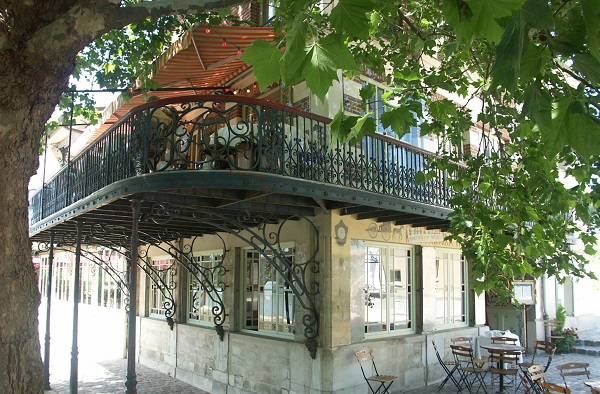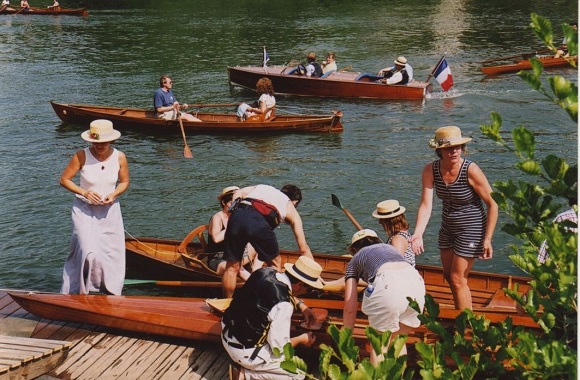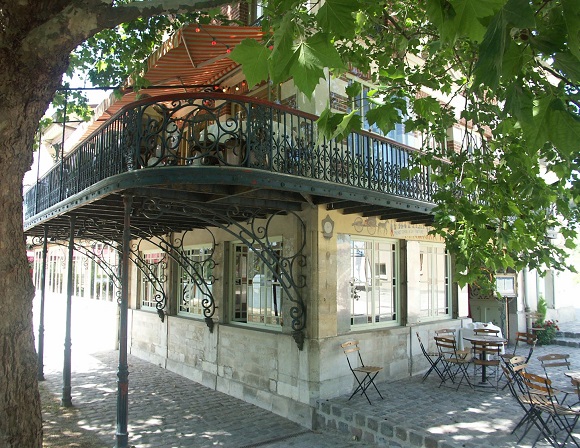
A short-lived round of horror arose in the museum world in October 2007 when it was discovered that a band of drunken intruders had broken into the Musée d’Orsay at night and that one of them had punched a hole in Claude Monet’s Le Pont d’Argenteuil (Argenteuil Bridge).
The horror quickly faded for three reasons: the curators of the Orsay described the damage as an easily repairable tear; there are enough Monets in Paris to fill the temporary void; no one was about to buy or sell the painting; and, perhaps most importantly, the intruders, who were quickly found, immediately and adequately explained the reason for their actions: “We were drunk.”
Meanwhile, several days after the guy punched the Monet, some gal went on trial for kissing an all-white painting by Cy Twombly at Avignon’s Musée d’Art Contemporain four months earlier, an act that left a difficult lipstick stain on the canvas. If she’d simply punched the painting it would have been both easier to restore and easier to explain as a response to contemplating a white space, but girls will be girls.
The outrage in the case of the kiss was far greater than that of the punch, and it was self-aggrandizing outrage at that, caused not so much by the kiss itself but by so many people trying to analyze it and abstract large theories from it. Once the abstraction had begun everyone wanted a piece of the conversation.
First there was the kisser, who tried to defend herself by saying that the kiss was an act of love “that the artist would have understood.” Then the media and editorialists dove into the issue of the meaning of the kiss as through there were a real debate to be had. And the museum and its art handlers saw this as an occasion to put a self-promotional spin on their outrage by claiming that contemporary art itself had been attacked.
Only the artist—an American, I note, though without wishing to read much into that fact, so let’s just say a foreigner—stayed beyond the fray and simply hoped that his embraced work could be cleaned.
The woman’s “act of love” argument holds far less water than the “we were drunk” of the intruders in the Orsay, yet it excited the talking heads in the art world in France because it gave them the occasion to discuss the finer points of love, contemporary art, and vandalism. The directors of the museum promptly found a way to channel their outrage so as to take advantage of the attention of what they considered “the phenomenon of summer”; they set about mounting an exhibit entitled J’embrasse pas. The museum’s website proclaims that the exhibit, “was imposed following the proposition ‘Statement’ by Lawrence Weiner: ‘J’embrasse pas’ (I don’t kiss),” which is a bit like creating a war so as to sell an excess cache of arms, with conceptual art claiming that it had no choice but to fight back a misplaced kiss with freely advertised hype.
I can’t help but feel that the museum directors were secretly disappointed that the Twombly hadn’t been punched and the Monet kissed since not only is rejection the fight they were truly itching for but they’re likely to have more “I don’t punch” works available.

Thanks to the kisser’s trial and current “don’t kiss” exhibit the phenomenon of summer has stayed in the news longer than the phenomenon of autumn, but I thought the event in the Orsay much more compelling and revealing. For one, it shows that there’s still life in the old master Impressionist and not just merchandising.
The Orsay intruder seemed to indicate that there was nothing significant about the choice of the Monet for his fist. Seeing images of the vandalized painting, however, I couldn’t help but recognize the tear as (being imposed by) some kind of drunken, cartoonish, and/ or artful statement about museums. I am reminded of that moment in Raiders of the Lost Arc de Triomphe when Indiana Jones, menaced by a sword-welding hulk and finding no exit, widens his eyes to his trademark oh-shit expression then pulls out a gun and shoots the guy. Simply shoots the guy, I should say, just as the drunken intruder in the museum, annoyed with Monet’s impressionistic artifice, or at least by its being presented as something sacred and permanent, simply took out his only available arm (the other probably occupied by a beer) and punched the damn thing smack in its river.
When I get fed up with a book for similar reasons I just fling it across the room then pick it up later to continue reading, with the worst consequence being that I’ve lost my place. Since canvas art in a museum, unlike a book at home, isn’t our personal property, most of us manage to keep our punching (or kissing) reflexes in check visiting museums. Still, I must admit that there are times when visiting the attic rooms at the Orsay when I wouldn’t mind punching a few paintings myself. Something about the frames and the attic give me a claustrophobic urge to quit the art(ifice) and get some air.
Don’t get me wrong, I’m a big fan of the hand and eye of Monet: the Cathedrals of Rouen and sun-dappled backyards at the Orsay; the fog, steam, snow, and late Water Lilies at the Marmottan; the bold, expansive Water Lilies at the Orangerie. Monet is an enormous presence in Paris. But sometimes one gets fed up with the ephemeral being presented as the eternal, tired of the pretense of the museum experience altogether.
* * *
Le Pont d’Argenteuil, the punched painting, depicts a view across the Seine to Argenteuil, two tight bends in the river from Paris. Painted in 1874, the year Monet and fellow artists exhibiting off-Salon came to be called Impressionists, the work uses a new language of art to speak about a new form of leisure: the daytrip from Paris.
There are two sailboats in the foreground, a café (guinguette) in the background, the titular bridge advancing horizontally over the horizontal river, and those three natural cohorts of impressionism and of Parisian day-trippers: water, sky, and vegetation. (The recent tear has the unintended genius of echoing both the sailboats and the flow of the river.) Though absent of people, it’s a scene that has all of the elements so dear to a day-tripping train-setter from Paris in the 1870s.
And to avant-garde artists of the time. Carrying their now-fangled paint tubes and box easels, Monet, Sisley, Pissaro, Renoir, and other sought their inspiration along the tracks. In 1869 Monet and Renoir spent a collaborative summer dabbing the light on the Seine around La Grenouillère, a floating café at Croissy-sur-Seine, about eight miles downstream of Argenteuil. Monet eventually settled in Argenteuil in 1872 and lived there for six years.
What may have triggered the punch-drunk intruder at the Orsay to pull his fist at the sight of Argenteuil Bridge may well have been the same trigger that brought Monet to Argenteuil in the first place: the desire to get away from the national museums and official salons and their high-nosed view of art. The intruder must have further found that plein air work didn’t make him want to see more plein air work, it made him want to be out in plein air.
Few painters have infused their outdoor scenes with more of such a sense of place—observed place—than Monet. But Monet was not a painter of wilderness or even of solitude outdoors. The natural space he framed is always a space where people work and/or play, even if those people are rarely seen. Ever since his style gained popularity, the natural effect of seeing his work has been for viewers to wants to enter into and to witness that space for themselves, which largely explains the success of his home at Giverny as a destination for artists in the early years, then for tourists.
In Renoir’s outdoor scenes, on the other hand, people are an integral part of the space, nearly a part of the foliage, nevertheless taking center stage. Viewing his work makes you want to attend a picnic or garden party or outdoor dance or at least sit out on a lively café terrace. They make you want to be a witness to human nature: the conversations, flirting, brushing up, silly laughs, tête-à-têtes, posing, absent stares, and seductive glances.
I’m thinking of course of two of Renoir’s most well-known paintings—Bal au Moulin de la Galette (1876) at the Orsay and Le Déjeuner des Canotiers (The Luncheon of the Boating Party, 1881) in the Phillips Collection in Washington, D.C.
Bal makes me want to go people-watching in a café in Montmartre, where the windmill of the Galette that gave its name to the outdoor ball still exists. Déjeuner makes me want to go to déjeuner (lunch).

Les Déjeuner des Canotiers (Luncheon of the Boating Party) is one of Renoir’s last major classic Impressionist works, before he became a family man and his subjects got so rosy-cheeked and zaftig. It presents a gathering on the balcony of a restaurant at the end of lunch after a morning of rowing on the Seine, with the canotiers posing as weekend warriors showing off in muscle shirts and chatting up charmed and charming women, without any eyes meeting.
That scene takes place on the balcony of the restaurant Maison Fournier situated on an island at Chatou, easily reached (then as now) nine miles out from Paris. It’s less than a mile upstream from where Renoir and Monet came to work in the summer of 1869 and six miles downstream of Argenteuil. In 1881, having sketched and painted in various zones along the Seine, Renoir and his friends took a hanging out on this lively piece of island at Chatou known as a center for boating on the Seine. Day-trippers could rent boats and everyone eventually stopped into Maison Fournier. Renoir would occasionally ask for a room to spend the night. Monet, Degas, and Whistler, Flaubert, Maupassant, and Zola also stopped by along with numerous Parisians happy to leave the city for the day. The portion of the island that once attracted Renoir and the others is now called the Ile des Impressionnistes.
Getting a taste for the daytrip of Renoir and Parisian day-trippers of the time you need simply sit down for lunch at the very same Maison Fournaise, preferably on its very same balcony overlooking the river (see photo to right, second from top). The view across the river is distinctly business-suburban, yet the historical authenticity of the setting and the quality of the cuisine bourgeoise at Maison Fournaise make for an enchanting and easy detour from Paris for lunch. An adjacent museum honors the presence of artists and day-trippers here, mostly through reproductions and artifacts.
The greater folklore of the island though is found in the workshop across the square from the Maison Fournaise, where an association of canotiers and craftsmen continues the tradition of leisure boating along the Seine, sometimes by floating boat and more often by restoring them. The workshop is run by the Association Sequana which is dedicated to restoring (and constructing facsimiles of) old skiffs, gigs, canoes, and small sail boats from about 1880 to 1950, with a particular devotion to those high times of boating on the Seine at the end of the 19th century.
Donning straw hats and striped shirts, association members offer one-hour “Impressionist cruises” on weekend afternoons from May to October to other sites where easels were once set up along the river (see their website for exact schedule). Cruise or not, weekend or not, the curious travelers, particularly the traveler curious about boating, shouldn’t hesitate to peek into the boatyard/workshop and, language permitting, inquire about recent restorations.
After déjeuner at Maison Fournaise and meeting a canotier or two, you need only gaze into the shimming waters of the Seine to imagine the work and play of artists and day-trippers at the time. Among them, I can well imagine the guy who punched the Monet knocking back a few glasses along the riverbank and throwing stones into the water to annoy boaters. And the gal who kissed the Twombly, she could just as easily fall in love the veneer of a skiff and expect the Association Sequana to excuse the lipstick mark and to understand. I’m sure they would.
© 2007 by Gary Lee Kraut
Getting There
Take suburban RER line A1 from Paris to Rueil-Malmaison, which takes about 20 minutes. Ile des Impressionnistes is then a 5-minute walk straight in the direction of Chatou.
Idea for a Daytrip
Ten minutes beyond Rueil-Malmaison RER line A1 reaches Saint-Germain-en-Laye (see that article). The two can therefore easily be combined on a daytrip, i.e. lunch at Maison Fournaise and a glimpse in the workshop followed by a late-afternoon stroll-about at Saint-Germain-en-Laye. One might start off the day by viewing the Monets and Renoirs at the Musée d’Orsay (closed Monday) or by visiting the tremendous Impressionist collection at the Musée Marmottan Monet (open daily).
Useful Links
Restaurant de la Maison Fournaise: www.restaurant-fournaise.fr.
Musée Fournaise: www.musee-fournaise.com.
Association Sequana: www.sequana.org.
The above three share the same mailing address: Ile des Impressionnistes, 78400 Chatou.
Musée d’Orsay: www.musee-orsay.fr.
Musée Marmottan Monet: www.marmottan.com.
Links to images of paintings mentioned in this article
Monet’s Pont d’Argenteuil
Renoir’s Bal au Moulin de la Galette
Renoir’s Le Déjeuner des Canotiers / The Luncheon of the Boating Party

